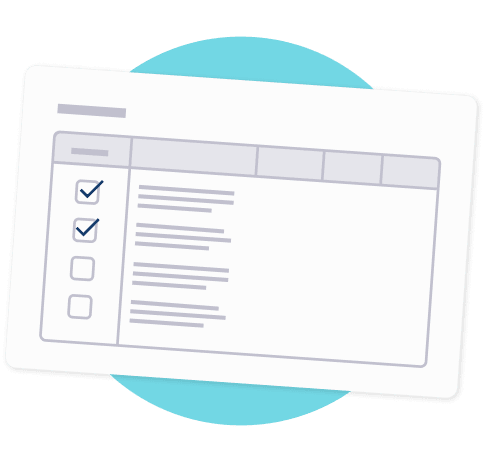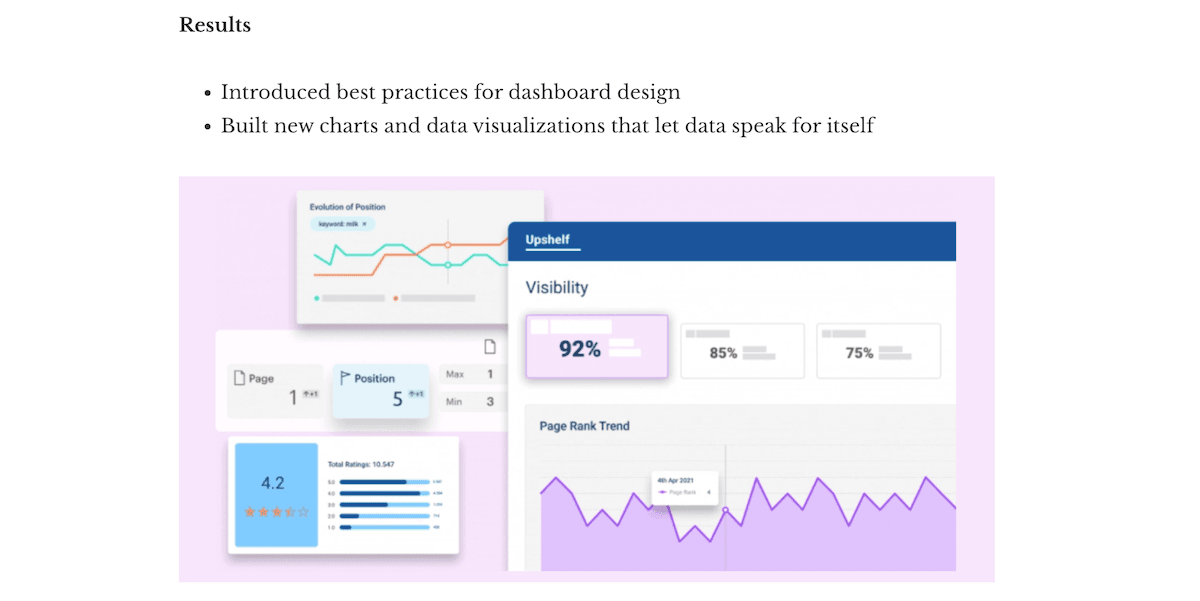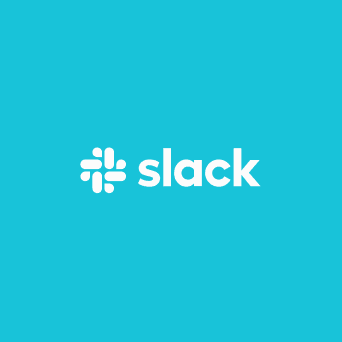Updated: December 3, 2025- 15 min read
Breaking into product management can seem daunting, especially with the diverse skill set required to succeed in the role. In this guide, we’ll break down actionable steps to help you get started, build your skills, and find your first product management job. We’ll also explore how professionals from various backgrounds—such as marketing, engineering, and design—can transition into product management roles.
Interview Prep Checklist
Land your dream job with expert-approved example answers and proven frameworks!
GET THE CHECKLIST
1. How to Get Started in Product Management: Foundational Knowledge
Breaking into product management begins with a solid foundation built on basic knowledge of the core principles that guide product managers in their day-to-day work.
You’re just starting out, so remember, you don’t have to be an expert in anything yet. A general working knowledge will help you succeed in the steps to follow. You’ll be able to take better advantage of certifications, join the conversation at conferences, and, eventually, ace an interview.
But let’s not get ahead of ourselves! This step is also about making sure product management is right for you. Do the topics below perk your interest? Do you find yourself going down a Product Management YouTube rabbit hole? If so, you’re off to a good start.
The good news is there are a ton of affordable and even free resources to get you started, including:
Free articles on product management topics
Webinars for PMs by PMs
These types of free resources from trusted sources will help you stay updated on industry trends and best practices.
If you’re not sure where to begin, consider getting started with these five core topics that every PM should know:
Product Management Process – Understanding the entire journey of a product, from conception to sunset, and the steps involved in developing, launching, and maintaining a product.
Product Discovery – Knowing how to gather feedback and insights from users to drive product decisions is critical for aligning the product with customer needs.
Product Strategy – A PM must be adept at converting the product vision into a strategy, prioritizing features, and executing the strategy via a roadmap.
Product Analytics – Success in product management is driven by data. You’ll need to learn how to track product metrics and use them to inform product decisions.
Cross-functional Collaboration – PMs work across teams, including engineering, design, and marketing. Mastering collaboration and communication skills is key to driving successful outcomes.
2. Earning a Product Management Certification
These foundational topics are vital for anyone starting their product management journey. Diving into quality resources will not only build your knowledge but also prepare you to apply these concepts in real-world scenarios.
One of the most effective ways to kickstart your product management career is by earning a Product Management Certification. This formal training offers a structured path to learn from experienced product professionals who have successfully navigated the industry.
When looking for the right certification, the most important criterion is that it be taught by Silicon Valley product leaders, providing invaluable insights and real-world examples that can help you develop the skills needed to thrive in a product management role.
Certifications equip you with both theoretical knowledge and practical application. You’ll gain a deep understanding and hands-on experience with key Product Management skills, including:
These programs often include hands-on projects, allowing you to apply what you’ve learned in real-world scenarios, further building your confidence and expertise.
Another key benefit of certification is the network to which you gain access. By learning alongside peers and connecting with instructors, you’ll find yourself in a community of like-minded individuals who share the same passion for product management. These connections can prove invaluable when seeking advice, support, or even job referrals as you transition into the field.
Product Management Certification
Master the essential PM toolkit: build roadmaps, define PRDs, analyze users, and launch products leveraging the latest AI-first strategies.
Enroll now
3. How to Get Product Management Experience: Apply Your Skills
Once you’ve built your foundational product management skills, the next step is to apply them in real-world scenarios through personal projects, volunteer work, or internships. Gaining hands-on experience will help you find a product management role and is also a great way to network (more on that in Step 5!).
Here are some practical ways to get started:
Work on Personal Projects: Identify a problem you face in daily life or work, and use your PM skills to develop a solution. For example:
Create a mobile app to address a specific pain point.
Redesign a website to enhance the user experience.
Improve a workflow by introducing a new digital tool.
Personal projects not only help you apply your skills but also serve as excellent portfolio pieces to showcase to potential employers.
Volunteer for Nonprofits: Sites like Taproot offer opportunities to work on real projects that benefit causes. Organizations like Techfleet help aspiring PMs collaborate on real projects.
You can also reach out to organizations in your community that could benefit from the PM skillset, including research into donor personas, process improvement, campaign roadmapping, and data analytics.
Pursue Internships: Associate Product Manager (APM) programs are another way to get hands-on experience at a highly regarded company.
4. Build a Product Manager Portfolio
Creating a product manager portfolio is a great way to stand out when applying for product management jobs. A portfolio allows you to showcase your work visually, giving potential employers deeper insights into your skills, projects, and hands-on experience. Unlike a CV, which lists your qualifications chronologically, a portfolio is a dynamic, detailed representation of your abilities, using real projects and case studies to tell your story.

Source: Screenshot taken from Anita Valentinova's portfolio
Here’s what a strong portfolio should include:
Case studies that highlight products you’ve worked on, challenges faced, and solutions provided.
Data and metrics to demonstrate the impact of your work.
Images, mockups, or videos to create a more engaging visual experience.
A narrative that walks the viewer through your product management journey and key accomplishments.
Portfolios can take many forms:
Personal websites with dedicated portfolio sections.
Curated blogs that focus on your product management expertise.
Creative formats such as video, social media profiles, or Notion pages.
For inspiration, check out these product manager portfolio examples, ranging from minimalistic designs to detailed case studies. A well-organized portfolio will not only help with job applications but also serve as a valuable tool during interviews, allowing you to demonstrate your hands-on experience.
5. Network with Product People: Join the Conversation
Networking is critical to building a successful career in product management. By connecting with other professionals in the field, you can learn from their experiences, share knowledge, and even uncover job opportunities. Whether you're looking for guidance, mentorship, or simply to expand your network, getting involved in the product management community is key.
Here are two excellent ways to start networking:
Attend ProductCon
Organized by Product School, ProductCon is a huge gathering of product professionals. It’s held four times a year and covers the hottest topics in product management. Whether you attend online for free or join in person, ProductCon provides plenty of opportunities for networking. You’ll have the chance to connect with fellow PMs, exchange insights, and learn from some of the top leaders in the industry.
Join Us at ProductCon
The World’s Largest Product Conference. Attend in person or for free online!
FREE TICKETS
Join the Product School Slack Community
With over 100,000 product managers in the community, the Product School Slack community is a fantastic place to network. It’s free to join and gives you access to AMA sessions, local PM channels, and answers to over 20,000 product management-related questions. You’ll be able to connect with PMs at all stages of their careers, discuss best practices, and find solutions to challenges you're facing.
Discover the World's Largest Product Management Community
Join Product School's private Slack community and network with over 100,000 PMs.
Join Now
Building relationships within the product management community is essential for staying current and opening up new career opportunities. Start by joining these spaces and actively participating in the conversation.
6. How to Get a Product Manager Job: Application Strategies
Landing your first Product Manager job or advancing in the field can feel overwhelming, but strategic planning can set you up for success. Be proactive in your job search by applying to a variety of roles, including those slightly outside your comfort zone. Consider early-stage startups where you can take on broader responsibilities. Most importantly, don’t take rejection personally—it’s a natural part of the process. Every interview is an opportunity to network and learn, bringing you closer to your dream PM role.
Writing a great cover letter
Crafting a Product Manager cover letter is a crucial step in landing your ideal role. While 31% of job applicants skip this step, a compelling cover letter can set you apart from other candidates. It's your chance to go beyond your resumé and tell a story that aligns your skills with the company’s objectives and culture.
Start by researching the company in-depth. Tailor your cover letter by showcasing your relevant achievements and demonstrating how your experience will benefit the organization. Be concise—aim for three to four short paragraphs—and focus on quality over quantity.
Highlight your unique value by connecting your accomplishments to the company’s specific needs. If you're new to product management, emphasize transferable skills from other roles. Lastly, end with a strong call to action, such as expressing interest in an interview, and proofread thoroughly for a polished finish.
Use Product School’s cover letter template to ensure your letter will make a lasting impression and increase your chances of landing the role:
Cover Letter Template
Seeking the next step in your Product journey? Use our template to spotlight your strategic brilliance and land your ideal role. Our Product Manager Cover Letter Template is your key to standing out!
Free template
Crafting a Product Manager CV
Your product manager resumé is your professional passport, showcasing the highlights of your career. The key to an effective CV is knowing what to leave out—focus on the most relevant experiences that align with the role you're applying for. Create a Master CV with all your experience. Then, as you apply for each position, remove irrelevant items and tailor your language and achievements to match the job description.
Avoid common mistakes like including irrelevant achievements, using overly casual language, or boasting excessively. Instead, highlight the accomplishments that demonstrate your impact, providing context and data where possible. For example, explain how you improved retention rates by X% or launched new monetization channels that boosted revenue.
Keep your CV concise, ideally one page, and focus on building a coherent story that shows your career progression and the product management skills you've acquired. Whether you choose a traditional format or a creative design, ensure your CV is professional and aligned with the company’s preferences.
7. Product Management Interview Preparation
Acing a product management interview requires thorough preparation. At Product School, we’ve gathered insights from seasoned product leaders to help you navigate the common types of interview questions, so you’ll be ready for everything from product sense and technical questions to behavioral and personal ones.
Some common product management interview questions include:
How would you improve our product?
Tell us about a time you used data to influence a stakeholder.
What’s your approach to prioritizing a product backlog?
To answer these effectively, use proven interview question frameworks like the STAR and CIRCLES methods. These approaches help structure your answers clearly, highlighting your problem-solving process and product insights.
Tailoring your answers to the specific company and referencing your own experience will help you stand out. Preparing for interviews is not just about having the right answers but demonstrating your unique value and enthusiasm for the role.
Interview Prep Checklist
Land your dream job with expert-approved example answers and proven frameworks!
GET THE CHECKLIST
Succeed in Your First Product Manager Job
The first few months in your first product manager job can set the tone for your success. In this crucial period, focus on learning, building relationships, and securing early wins. Start by understanding your role, your team dynamics, and the company’s broader goals. Immerse yourself in the product, exploring its features, past milestones, and user feedback. Gaining this knowledge will guide your decisions and help you hit the ground running.
During the first 30 days, prioritize learning. In the next 30 days, begin contributing to small projects and celebrating quick wins. By the 90-day mark, you should be confident enough to take charge of product launches, lead meetings, and solidify your strategy.
Mastering relationships with both cross-functional teams and leadership is key. Establish credibility by securing early wins, aligning your actions with company objectives, and celebrating team successes. Most importantly, take ownership of your role by embracing responsibility and ensuring the team stays on course.
For more on this, check out this webinar by Meta Product Leader, Swaroop Desai on your first 90 days as a PM:
How to Transition to Product Management
It’s such a diverse field...[Product Managers] have all sorts of backgrounds. They will be people who used to be programmers, or former CEOs of startups, people with UX backgrounds… and that’s the thing. You don’t need to be what someone else is.
— John Franck, author of Every Product Manager’s First 90 Days
Transitioning into product management from another role is a common career path for PMs. Whether you're coming from marketing, engineering, design, or other fields, your current skills can be valuable assets in product management. The key is to leverage your expertise, build foundational product knowledge, and demonstrate how your experience aligns with the responsibilities of a product manager.
In the following sections, we’ll explore how to successfully transition into product management from various roles, providing actionable insights and tips tailored to each path.
From Marketing to Product Marketing Manager (PMM)
If you're a marketer with a passion for products, transitioning into a Product Marketing Manager (PMM) role is a natural next step. As a PMM, you’ll be responsible for positioning the product, creating go-to-market strategies, and working closely with both the product and sales teams to ensure successful launches. Your marketing expertise in understanding customer needs, crafting compelling messaging, and driving demand generation will serve as a strong foundation.

Julia Szatar
Head of Product Marketing, Loom
The product marketing career path often leads to product management, as PMMs are deeply involved in understanding the product lifecycle, customer feedback, and market trends. By collaborating with product managers and learning more about the technical and operational aspects of product development, you can build the skills needed to transition into a full product management role.
With a solid background in marketing, you're already well-equipped to make this transition, as many of the strategic and customer-focused elements of marketing align closely with product management responsibilities.
Go-to-Market Certification
Create a winning GTM plan. Craft standout positioning, design messaging that sells, analyze markets, and drive post-launch momentum, all while leveraging the latest AI-first strategies.
Enroll now
Transition from Engineer to Technical Product Manager
Product management is a great alternative career for software engineers. For engineers looking to move into product management, the role of a Technical Product Manager is a great fit. Technical PMs focus on the more technical aspects of product development, such as working closely with engineering teams to ensure the feasibility and execution of product features. Engineers already possess many skills that are highly transferable to this role, including:
Technical expertise: Deep understanding of product architecture and technical challenges.
Problem-solving: Ability to break down complex problems and find practical solutions.
Collaboration: Experience working cross-functionally with design, QA, and operations teams.
Agile methodologies: Extensive experience working within agile frameworks like Scrum or Kanban, making you adept at iterative development and prioritizing tasks.
Transitioning to Product Management from Design
For designers looking to move into product management, the role of a Product Designer is a great stepping stone. Product designers focus on creating user-centered designs while working closely with product managers to ensure features meet user needs and business goals. Designers bring many valuable skills to this role, including:
User experience (UX): Expertise in crafting intuitive, user-friendly interfaces.
Visual design: Ability to create aesthetically pleasing and functional designs for products.
Prototyping and testing: Experience in rapid prototyping and gathering user feedback to iterate on designs.
These skills make designers well-prepared to transition into a product design role, bridging the gap between design and product strategy.
Other Roles that can lead to Product Management
Several roles have significant overlap with product management, making them natural transitions:
Project Manager: Project Managers excel in managing timelines, scope, and resources, which are critical skills for Product Managers. Their experience in coordinating teams and ensuring project delivery aligns well with the demands of product management.
Sales Rep: Sales professionals, especially in product-led sales, understand customer pain points and can leverage this knowledge to shape product features that meet market demands. They are adept at communicating the value of a product, which is essential for aligning product strategy with business goals.
Business Analyst: Business analysts are skilled in gathering requirements, analyzing data, and providing insights that inform product decisions. Their experience with data-driven decision-making makes them ideal for transitioning to product management roles, especially that of Data Product Manager.
Product Owner: A Product Owner often serves as the bridge between business and development teams, prioritizing backlogs and ensuring alignment with product goals. This role closely mirrors many responsibilities of a product manager, making the transition seamless.
You’ve heard the expression, "All roads lead to Rome." Well, many paths lead to Product! Products are built for everyone, so they need to be built by everyone. Having a variety of perspectives and strengths and weaknesses actually builds a product team.
Breaking into product management is a journey that requires learning, networking, and gaining hands-on experience. By following the steps outlined here, you’ll be well on your way to landing your first role and thriving in it. Whether you’re transitioning from marketing, engineering, or another role, the skills you bring to the table are valuable assets in product management. With determination and a focus on continuous learning, you can successfully carve out your path and make an impact in this exciting field.
Product Management Certification
Master the essential PM toolkit: build roadmaps, define PRDs, analyze users, and launch products leveraging the latest AI-first strategies.
Enroll now
Updated: December 3, 2025




